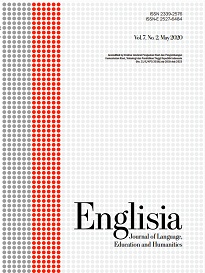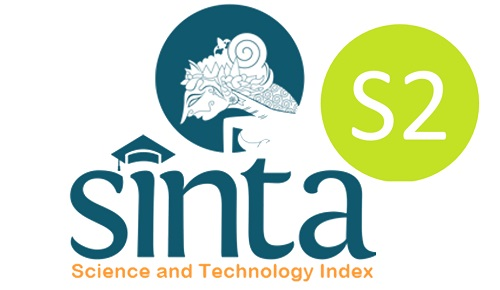Online English speaking instruction in junior high schools: Readiness and obstacles
DOI:
https://doi.org/10.22373/ej.v10i2.15043Keywords:
teaching online speaking, teachers’ readiness, obstaclesAbstract
In the midst of a pandemic, teaching speaking online becomes one of the challenges. This study investigates whether or not English teachers were prepared to teach speaking virtually. Consequently, the purpose of this study was to determine the English teachers' readiness and obstacles to teaching speaking online during the pandemic Covid-19. The researcher utilized mixed research methods to conduct this study. The information was gathered via questionnaires and interviews. The experts have tested and validated these instruments. The data were then quantitatively and qualitatively analyzed. Quantitative data were analyzed with the aid of SPSS statistical calculations. In contrast, qualitative data were analyzed using multiple steps, including data reduction, data presentation, and conclusion. The results indicated that the majority of English teachers were prepared to implement online speaking instruction during a pandemic, despite the fact that some teachers were not quite prepared due to several obstacles. As for the challenges encountered by English teachers, there were online speaking assessments, poor connections, low interaction, and a lack of learning devices. Shortly, English teachers prepared to teach online speaking to students in order to improve the students' speaking ability, despite the emergence of certain obstacles.
Downloads
References
Afolabi, A. A. (2015). Availabality of online learning tools and the readiness of teachers and students towards it in Adekunle Ajasin University, Akungba - Akoko, Ondo State, Nigeria.ELSEIVER, 176 (2015) 610 - 615. https://doi.org/10.1016/j.sbspro.2015.01.17
Churiyah, M., Sholikhan, S., Filianti, F., & Sakdiyyah, D.A. (2020). Indonesia education readiness conducting distance learning in covid – 19 pandemic situation.JMMU. Journal International of Multicultural and Multireligious Understanding.7(6), 491 – 498. https://doi.org/10.18415/ijmmu.v7i6.1833.
Creswell, J.W. (2014).Research design qualitative, quantitative and mixed methods approaches.Sage Publications.
Goh, C. C. M., & Burns, A. (2012).Teaching speaking, a holistic approach.Cambridge University Press.
Hanifa, H. (2017). Improving the ability of teachers in developing learning planning through collaborative coaching for grade V teachers in dabin II education unit of gedangan sub- district.PEDAGOGIA. Jurnal Pendidikan.6(2), 195 – 200. https://doi.org/10.21070/pedagogia.v6i2.939.
Husain, B, Idi, N. Y., & Bari. M. (2020). Teachers perception on adopting e-learning during covid – 19 outbereaks; advantages, disadvantages, suggestions.JT. Journal Tarbiyah. 27(2), 41-57. DOI: http://dx.doi.org/10.30829/tar.v27i2.738
Hogg, M.A., & Vaughan, G.M. (2018).Social psychology(8th ed). Pearson Education Limited.
Jamal, S. (2020). Analasis of e-learning readiness during the covid – 19 pademic at smk n 1 tambelang.JKPPK. Journal Kajian Penelitian dan Pengembangan Pendidikan.8(1)., 16-22. learning during the covid-19 pandemic in smk negeri 1 tambelangan. DOI: https://doi.org/10.31764/paedagoria.v11i2.2467
Kementrian Pendidikan dan Kebudayaan Republik Indonesia (2020). Surat edaran no. 4 tahun 2020 tentang pelaksanaan kebijakan pendidikan dalam masa darurat penyebaran corona virus disease(covid – 19).
Koo, A.C. (2008). Factors affecting teachers’ perceived readiness for online collaborative learning: a case study in Malaysia.ETS. Educational Technology and Society.11(1), 266 – 278. https://www.jstor.org/stable/jeductechsoci.11.1.266
Louwrens, N., & Hartnett, M. (2015). Student and teacher perceptions of online student engangement in an online middle school.JODL. Journal of Open Flexible adn Distance Learning.19(1), 27 – 44. https://eric.ed.gov/?id=EJ1068364
Maddox, N., Forte, M., & Boozer, R. (2000). Learning readiness: An underapreciate yet vital dimension in experiential learning. Developments in Business.
Mahajan, V.M., & Kalpana. R. (2018). A study of students’ perception about e-learning. IJCAP. Indian Journal of Clinical and Anatomy physilogy.5(4), 501-507. https://doi.org/10.18231/2394-2126.2018.0116
Miles, M. B., Huberman, A. M., & Saldana, J. (2014). Qualitative data analysis: a methods sourcebook.SAGE Publications, Inc.
Mulyadi, D. (2018). EFL student teachers’ perception and challenges toward online platforms in language pedagogy.ELLIC. English Language and Literature International Conference.2(2). 321-323. Electronic ISSN: 2579-7263 CD-ROM ISSN: 2579-7549
Ngoc-Phan, T.T. , & Thao-Dang, L.T. (2017). Teachers readiness for online teaching: a critical review.IJODeL.International on Open and Distance e-learning,3(1) 1-16 https://ijodel.com/wp-content/uploads/2017/12/001_Phan_Dang.pdf
Okinda, R.A (2014). Assesing e-learning readiness at the kenya technical teachers college.
Journal of Learning for Development,1(3), https://jl4d.org/index.php/ejl4d/article/view/32
Rahayu, P.R., & Wirza, Y. (2020). Teachers' perception of online learning during pandemic covid - 19.JPP. Journal Penelitian dan Pendidikan.20(3), 392-406.
DOI: https://doi.org/10.17509/jpp.v20i3.29226
Sari, P.W, Pramesti. D., & Kusuma, I.A. (2020). Students' perception of online learning in pandemic. PROCEEDING.Universitas Muhammadiyah Surabaya.201-207. ournal.umsurabaya.ac.id/index.php/Pro/article/view/5977/3115#
Saputri, A. D. (2017). Analysis of teachers' readiness in teaching english to young learners at kindergartens.Repository IAIN Salatiga..1-100.http://e- repository.perpus.iainsalatiga.ac.id/1366/Scherer, R. Howard, S.K., & Siddiq. F. (2020). Profiling teachers' readiness for online teaching and learning in higher education: who's ready ?.ELSEIVER, 118, 1-16.https://doi.org/10.1016/j.chb.2020.106675
Sidqi, A.N. Auliya, P. (2020). Analysis of teacher readiness in distance learning during covid- 19.JKKMP. Journal Kajian Keislaman Multi- Perspektif.1(1), 137-158. DOI: 10.22515/literasi.v1i1.3261
Sholihah, A.R. (2020). Practice of learning speaking skills during the covid pandemic - 19. JKPPP. Journal Kajian Penelitian dan Pendidikan dan Pembelajaran.5(1), 705-717. DOI: https://doi.org/10.35568/naturalistic.v5i1.977.
Thamarana, S. (2018). Teaching speaking online: Prospects and possibilities. Proceeding of Eltai Tirupathi Chapter 6th Annual International Conference.6(1), 23. https://www.researchgate.net/publication/323252357_Teaching_Speaking_Skills_Online_Prospects_and_Possibilities
Tiara, R.D., & Pratiwi, E. (2020). The importance of measuring teacher readiness as the basis of online learning in early childhood education institutions.JGA, Journal Golden Age, 4(2), 362-368. https://e-journal.hamzanwadi.ac.id/index.php/jga/article/view/2624/0
Waryanto, H.N., & Setyaningrum, W. (2014). E-learning readiness in Indonesia; a case study in junior high school Yogyakarta.PROCEEDING.76(2), 646 - 654. https://eprints.uny.ac.id/24344/1/E-76.pdf
Yuzulia, I. (2021). The challenges of online learning during pandemic: Students’ voices. Wanastra: Jurnal Bahasa dan Sastra. 13(1), 8-12.
Downloads
Published
Issue
Section
License
Proposed Policy for Journals That Offer Open Access
Authors who publish with Englisia journal agree to the following terms:
- Authors retain copyright and grant the journal right of first publication with the work simultaneously licensed under a Creative Commons Attribution License that allows others to share the work with an acknowledgement of the work's authorship and initial publication in this journal.
- Authors are able to enter into separate, additional contractual arrangements for the non-exclusive distribution of the journal's published version of the work (e.g., post it to an institutional repository or publish it in a book), with an acknowledgement of its initial publication in this journal.
- Authors are permitted and encouraged to post their work online (e.g., in institutional repositories or on their website) prior to and during the submission process, as it can lead to productive exchanges, as well as earlier and greater citation of published work (See The Effect of Open Access).









